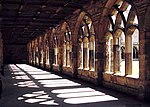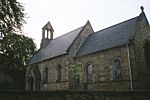Durham Dean and Chapter Library
10th-century establishments in England995 establishmentsAC with 0 elementsCathedral librariesDurham Cathedral ... and 1 more
Libraries in County Durham
The Durham Dean and Chapter Library (also Durham Cathedral Library) is located in Durham Cathedral, Durham, England. Founded in 995 AD, it is one of the largest English cathedral libraries. William de St-Calais donated 46 books. In the 19th century it was located in the Old Frater House, or Monk's Hall, on the south side of the cathedral's cloisters, situated there in 1680 by the Dean of Durham John Sudbury, who fitted up the building.
Excerpt from the Wikipedia article Durham Dean and Chapter Library (License: CC BY-SA 3.0, Authors).Durham Dean and Chapter Library
Dun Cow Lane, Durham Viaduct
Geographical coordinates (GPS) Address Website Nearby Places Show on map
Geographical coordinates (GPS)
| Latitude | Longitude |
|---|---|
| N 54.77294 ° | E -1.57676 ° |
Address
Durham Cathedral
Dun Cow Lane
DH1 3ES Durham, Viaduct
England, United Kingdom
Open on Google Maps











